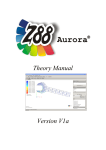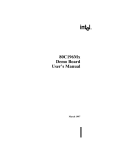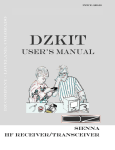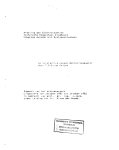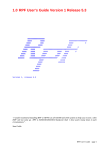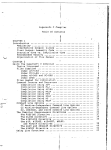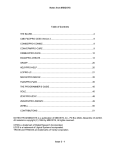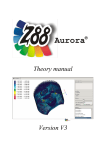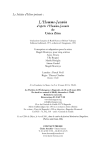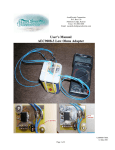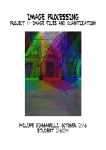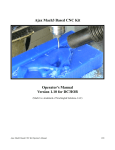Download Gamma-Ray Identification of Nuclear Weapon Materials
Transcript
UCRL-ID-127436
Gamma-Ray Identification of Nuclear Weapon Materials
T. B. Gosnell, J. M. Hall, C. L. Ham, D. A. Knapp, Z. M. Koenig,
S. J. Luke, B. A. Pohl, A. Schach von Wittenau, J. K. Wolford
February 3, 1997
ce re
n
re mo l y
w
r a r
La ive tion rato
L a o
N ab
L
This is an informal report intended primarily for internal or limited external
distribution. The opinions and conclusions stated are those of the author and may or
may not be those of the Laboratory.
Work performed under the auspices of the U.S. Department of Energy by the
Lawrence Livermore National Laboratory under Contract W-7405-ENG-48.
DISCLAIMER
This document was prepared as an account of work sponsored by an agency of the United States Government. Neither
the United States Government nor the University of California nor any of their employees, makes any warranty, express
or implied, or assumes any legal liability or responsibility for the accuracy, completeness, or usefulness of any
information, apparatus, product, or process disclosed, or represents that its use would not infringe privately owned
rights. Reference herein to any specific commercial product, process, or service by trade name, trademark,
manufacturer, or otherwise, does not necessarily constitute or imply its endorsement, recommendation, or favoring by
the United States Government or the University of California. The views and opinions of authors expressed herein do
not necessarily state or reflect those of the United States Government or the University of California, and shall not be
used for advertising or product endorsement purposes.
This report has been reproduced
directly from the best available copy.
Available to DOE and DOE contractors from the
Office of Scientific and Technical Information
P.O. Box 62, Oak Ridge, TN 37831
Prices available from (615) 576-8401, FTS 626-8401
Available to the public from the
National Technical Information Service
U.S. Department of Commerce
5285 Port Royal Rd.,
Springfield, VA 22161
UCRL-ID-127436
February 3, 1997
Gamma-Ray Identification of
Nuclear Weapon Materials
Principal Investigator: T. B. Gosnell
Co-Investigators:
J.M. Hall, C.L. Ham, D.A. Knapp,
Z.M. Koenig, S.J. Luke, B.A. Pohl
A. Schach von Wittenau, J.K. Wolford
An FY 1996 LDRD-ER Project
Final Report—96-ERD-062
Introduction
Contents
Introduction
The Gamma-Ray
Signature Recognition
Problem
A General Approach to
Gamma-Ray
Signature Recognition
Project Structure
Accomplishments in
FY 1996
1
1
3
8
10
Appendix A— Principal
Components analysis 16
Appendix B—Radiation
Physics Format
18
Appendix C—tcf System
Requirements
Specification–Rev. 0.1 30
Appendix D—Overview
of Background Radiation Measurements 51
There has been an accelerating national interest in countering nuclear smuggling. This
has caused a corresponding expansion of interest in the use of gamma-ray spectrometers
for checkpoint monitoring, nuclear search, and within networks of nuclear and collateral
sensors. All of these are fieldable instruments—ranging from large, fixed portal monitors to hand-held and remote monitoring equipment. For operational reasons, detectors
with widely varying energy resolution and detection efficiency will be employed. In
many instances, such instruments must be sensitive to weak signals, always capable of
recognizing the gamma-ray signatures from nuclear weapons materials (NWM), often
largely insensitive to spectral alteration by radiation transport through intervening materials, capable of real-time implementation, and able to discriminate against signals from
commonly encountered legitimate gamma-ray sources, such as radiopharmaceuticals.
Several decades of experience in classified programs have shown that all of these properties are not easily achieved and successful approaches were of limited scope—such as
the detection of plutonium only.
This project was originally planned as a two-year LDRD-ER. Since funding for 1997
was not sustained, this is a report of the first year’s progress.
The Gamma-Ray Signature Recognition Problem
Gamma-ray signature recognition is straightforward if signals are strong and high-resolution detectors can be used. The high-energy-resolution of these detectors provides
unambiguous identification of radionuclides (Fig. 1) using photopeak search algorithms.
1
A General Approach to Gamma-Ray Signature Recognition
However, in many applications the highest resolution detectors, high-purity germanium
(HPGe), are not practical because they are bulky, heavy, costly, delicate, and, because of
their cryogenic cooling requirement, difficult to support in the field. Newly emerging
instruments, using ambient-temperature CZT detectors, have energy resolution inferior
to HPGe but are still useful for photopeak identification. Unhappily the current state of
the art only produces diminutive CZT crystals—1 cm or less in size. Such detectors
require quite strong signals to capture a useful signal from measurements of endurable
duration for all but the lowest energy gamma rays. CZT detectors are therefore of greatest use in portable instruments that can be brought in close proximity of an item to be
monitored. The considerably greater detection efficiency of HPGe detectors is likely to
be best employed in highly sensitive applications where their high cost and cryogenic
cooling requirements can be justified.
Monitoring of vehicles at a border crossing is an example where signals may be very
weak and highly degraded, due to the contents of a vehicle. A similar example would be
the deployment of low-resolution sensors in a Wide Area Tracking System (WATS). In
such situations, the signal can be too degraded to produce detectable photopeaks in a
HPGe spectrum—even if deployment of such a detector is operationally practical. In
these conditions, large-area scintillation detectors have traditionally provided the
needed detection efficiency. However, these highly-efficient, but low-energy-resolution
detectors introduce their own problem. Because they typically do not produce resolved
photopeaks, the spectral data are more challenging to interpret. The most sensitive
spectral identification from scintillators is obtained by using the most general approach
to gamma-ray signature recognition. That is to analyze the pulse-height spectrum in its
entirety. This exploits the entire signal in the case of weak signals in high backgrounds
and recognizes the fact that most of the observable counts may lie in the continuum. As
traditionally practiced, however, the power of full spectrum analysis is severely
degraded if signature alteration occurs because of scattering and absorption by intervening materials. This Lifecycle Plan focuses on a general approach to analyzing such data,
while remaining equally useful with higher resolution detectors .
Fig. 2 schematically summarizes the domains of applicability of photopeak analysis and
full spectrum analysis for gamma-ray signature recognition as a function of signal
strength, detector energy resolution, and signal degradation from scattering and absorption.
A General Approach to Gamma-Ray
Signature Recognition
A general gamma-ray signature recognition capability must be able to cope with the following three obstacles that are commonly encountered.
1.
Low signal-to-noise ratio. The signals are sparse and background is high—not atypically more than 90% of the total counts recorded.
Gamma-Ray Identification of Nuclear Weapon Materials
2
A General Approach to Gamma-Ray Signature Recognition
2.
In spite of the fact that we know in detail the gamma-ray emission spectra of the
individual radionuclides of interest, the exact nature of the gamma-ray signatures
from the actual objects of interest are unknown. This occurs for three reasons.
• We don’t know the isotopic mixture of the radionuclides in the object.
• The objects of interest have varied and unknown geometries—leading to geometry-dependent signatures.
• Various materials will normally lie between the object and the detector, further
altering the already geometry-dependent signature.
Both the object itself and intervening materials cause scattering of radiation, resulting in partial energy degradation of the primary radiation. In the case of intervening
materials, already degraded radiation from the object can be further degraded. This
scattering, and further scattering within the detector, typically assigns most detectable events to a continuum between the photopeaks in the spectrometer’s pulseheight spectrum.
3.
Signals from commonly encountered natural and man-made gamma-ray sources can
compete with signals of interest and cause false alarms.
In spite of these difficulties, NWM spectra still retain unique, but typically subtle, features that can make them recognizable1.
Full spectrum analysis
The most straightforward approach to full spectram analysis is to cycle through a collection of “templates”—precomputed gamma-ray signatures for nuclear materials expected
to be encountered. These templates are compared serially to the observed spectrum.
Identification is made by choosing the template that best matches the observed spectrum. This approach works well, even with weak signatures, as long as the signature has
not been significantly degraded by scattering and absorption of intervening materials.
An example of where such a technique can work quite well is monitoring deplaning passengers at a customs check point. However, in more demanding applications, there are
number of drawbacks associated with such an approach.
While other approaches have been investigated, experience has shown that the most useful tool for comparison of full spectra is multiple linear regression. Multiple linear
regression minimizes the variance-weighted residual sum of squares (RSS) of a linear
combination of pulse-height spectra (such as background and plutonium) presumed to
make up the observed spectrum.
1. For completeness, we mention here that in some detection scenarios, particularly
nuclear search, background radiation intensity and spectral shape can change very
rapidly and complicate the analysis. In passby scenarios, the radiation signature of
the object of interest can also vary due to a time-dependent change in source/detector
geometry. Such temporal considerations were not within the scope of this LDRD and
can be considered independently.
Gamma-Ray Identification of Nuclear Weapon Materials
3
A General Approach to Gamma-Ray Signature Recognition
M
2
y –
β j x ij
N i
j=1
-
RSS =
(1)
-----------------------------σi
i=1
where y i is the value in the ith energy bin of the observed spectrum, and x ij is the value
in the ith energy bin of the jth source spectral component. These components include the
spectra from sources expected to be encountered (such as plutonium) and an independently measured background spectrum. The coefficients βj are free parameters, representing the intensities of the spectral source components and are determined by the
minimization process. If the statistical model (the linear combination of component
spectra) is an accurate representation of the measured spectrum, then the RSS will follow a χ2 distribution with ν = N – M degrees of freedom and the expectation value of
the “reduced chi-square” (i.e. χ2/ν) will be close to unity.
∑
Dealing with unknown
spectral signatures
∑
The obvious difficulty of applying multiple linear regression to our signature recognition problem is that we do not know, a priori, the identities of the source spectral components or how they might be altered by radiation transport. These alterations are
typically of considerable statistical significance, yielding RSS/ν values in excess of
unity. The model is then likely to be rejected by a χ2 test.
Full spectrum analysis as it is currently practiced. The use of multiple linear
regression requires accumulating a collection of radiation signatures for sources likely
to be encountered in the field. The most straightforward way to apply this technique is to
cycle through the collection, performing the regression with each candidate signature
and choosing the one that best matches the observed spectrum. Fig. 2 illustrates such an
approach schematically. There are number of drawbacks associated with such an
approach.
FIGURE 2. An example of full spectrum analysis as currently applied. The observed (unknown) spectrum is
compared by multiple linear regression to each of dozens of prospective characteristic signatures, yielding
as many results as there are signatures. The”best” result is then picked by some criterion such as minimum
ν.
value of RSS/ν
Gamma-Ray Identification of Nuclear Weapon Materials
4
A General Approach to Gamma-Ray Signature Recognition
1.
2.
3.
It is inefficient. Doing multiple fits is time-consuming and taxes the capability of
processors suitable for small, portable instruments.
It is rigid and inflexible. The fits must be done to the signatures as they are. There is
no means of adjusting for spectral shape alteration due to scattering.
It is insensitive to weak signals. Identifying a likely candidate from the signature collection is done not only by the goodness of the match, but by the strength of the signal, such as determined by the value of βj and its associated uncertainty,.σj. The ratio
βj/σj defines the signal-to-noise ratio of the candidate signature. To minimize false
alarms, βj/σj is typically required to exceed a value of 3.0-5.0 to qualify as a detection. The maximum value of βj/σj occurs when the signature is an exact match to the
observed spectrum. Inaccuracies in the signature due to scattering will cause lower
values of βj/σj, resulting in false negatives when this value dips below the detection
threshold.
A new approach: The single multicomponent signature. The key objective of this
project was to identify a small number of spectral components that, taken in linear combination, can form a single multicomponent signature that describes the signatures of all
NWM and legitimate sources that might be encountered. Once again, we rely on a collection of radiation signatures for sources likely to be encountered in the field. In this
case, we increase the size of the collection to include variations on signatures for particular sources in order to sample the effects of likely scattering geometries.
Our approach was to apply principal component analysis to this collection to achieve a
linear transformation that produces orthogonal eigenvectors that can reproduce all of the
data. Such an analysis is routinely used by statisticians as an automated means to find
complex signatures. The principal components have desirable properties that are wellsuited for multiple linear regression.
• They are orthogonal.
• They are automatically sorted from the most to the least significant.
• If the original components are carefully chosen then the principal components have
physical significance.
• Most of the variation in the collection is explained by the first few principal components.
These few principal components can be used as a single multicomponent signature (i.e.
as regressors in multiple linear regression) and related characteristic spectra will cluster
together in the principal component space, providing for signature interpolation. Principal component analysis is discussed in more detail in Appendix A.
Our approach to principal component analysis is illustrated schematically in Fig. 3. The
feature extraction step in the illustration is a key element in this project. Generally, we
will not retain the spectral data in the original pulse-height bins. We will rebin the data
adaptively to a smaller number of bins to emphasize structural features and deemphasize
the continuum. This is because one of the most significant drawbacks to the use of multiple linear regression is that the value of the goodness-of-fit estimator, RSS, is disproportionately affected by data in the continuum—a highly variable region notoriously
difficult to model accurately. Adaptive binning addresses the problem by reducing the
Gamma-Ray Identification of Nuclear Weapon Materials
5
A General Approach to Gamma-Ray Signature Recognition
impact of the continuum on the value of RSS. The continuum between photopeaks is
treated as a single large channel; the details of the shape of this region are thrown out
while the overall amplitude is preserved. This technique eliminates the necessity of
detailed modeling of the continuum, although the high sensitivity of the amplitude of
the continuum to the source geometry remains. Nonetheless, using this technique,
observed spectra and theoretical or template spectra can more quickly and effectively be
compared.
FIGURE 3. Application of principal component analysis to obtain a single multicomponent signature for
gamma-ray signature recognition. The features of hundreds of computed characteristic spectra are extracted
by adaptive binning prior to the principal component analysis. The analysis yields a single multicomponent
signature whose components, in linear combination, can describe spectral shapes of the original characteristic
spectra.
Signature recognition of an unknown spectrum is then accomplished simply by a single
fit to the multicomponent signature by multiple linear regression as illustrated in Fig. 4.
FIGURE 4. Signature recognition with a multicomponent signature. First the spectral features are extracted
using the same adaptive binning scheme used for the principal components analysis. The multicomponent signature is compared to the unknown using multiple linear regression. The euclidean distance from the fitted
spectrum is used to assign identification probabilities.
We can exploit the fact that the principal component space is in units of standard deviation to assign identification probabilities. The location of the fitted spectrum is projected
into the principal components space and its identification probability is determined by
its euclidean distance, in standardized units, from its nearest neighbors—clustered in PC
space (Fig. 5).
Evidence supporting the concept of using principal components regression for
gamma-ray signature recognition. The idea of using principal components regression
for gamma-ray signature recognition was pursued briefly a number of years ago by the
Gamma-Ray Identification of Nuclear Weapon Materials
6
A General Approach to Gamma-Ray Signature Recognition
principal investigator. However, efforts to exploit these ideas were limited by the cost of
experimental measurements of SNM and the cost and immaturity of computational simulations of gamma-ray pulse-height spectra at that time. Exploratory work done using
experimentally generated characteristic spectra for individual radionuclides was encouraging and provides more concrete examples of what can be expected. One of the experiments was directed at studying variations in the shape of NaI spectra of 60Co taken
through six combinations of scattering and shielding materials. In all, 94 spectra were
taken. They are all plotted together in Fig. 6a. The first three principal components
accounted for 94% of the variance in the data set and are shown in Fig. 6b.
FIGURE 5. Signature identification is accomplished by projecting the unknown
spectrum into the principal components space. Its identification probability is
determined from its euclidean distance, in standardized units, from its nearest
neighbors. In this notional diagram, we shown an unknown spectrum, represented by a black dot. The dashed circle represents a one-standard-deviation
uncertainty in its location. This unknown is most likely plutonium, since it overlaps the green domain representing a variety of plutonium spectra.
The projection of 94 spectra into the principal components space is shown in Fig. 7.
Clustering of the spectra into regions representing the scattering and absorbing materials produces domains similar to those envisioned in Fig. 5.
Gamma-Ray Identification of Nuclear Weapon Materials
7
Project Structure
FIGURE 6. Plots of 94 60Co spectra taken through 6 combinations of absorbers are shown in Fig. 6a. Feature
extraction in this case relied only on rebinning the original 256-channel spectra into 32 bins with bin widths
increasing in proportion to the energy resolution of the spectrometer. These first three principal components
of this data set are shown in Fig. 6b and account for 93.7% of the variance in Fig. 6a.
Project Structure
To produce a multicomponent signature, principal component analysis requires a large
set of signature samples. The only practical way to obtain a set of gamma-ray signatures
representative of the variety of NWM configurations and industrial and radiopharmaceutical sources is by computer simulation. This occurs for two reasons:
• A pure experimental approach would require a large number of measurements of
NWM which has become prohibitively expensive. We have reserved our measurements of NWM to a few items here at LLNL for validation of our computer simulations. Experimental measurements also have the disadvantage of being detectordependent.
• Simulated radiation signatures have the advantage that the most difficult, time-consuming, and expensive part of the calculations, Monte-Carlo radiation transport, are
detector-independent. Detector-dependent response functions can subsequently be
folded into the computed flux to obtain the pulse-height distributions for any detector of choice.
Gamma-Ray Identification of Nuclear Weapon Materials
8
Project Structure
FIGURE 7. Two-dimensional plots showing the 94 60Co data projected into the space formed by the first three
principal components. Clustering of the spectra by the type of intervening material through which the gamma
rays passed is clearly evident.
Using an ensemble of computer codes, we have demonstrated our ability to simulate the
complex signatures from thick NWM sources to accuracies of 5% or better. This set of
codes was satisfactory for producing a few simulations at a time. Producing the signature set for this LDRD required an upgrade of our capability to perform production simulation.
This project proceeded along six lines of effort, with the first five devoted to providing
the large data set required for signature recognition algorithm development and a final
line of effort for developing and testing the signature recognition algorithm.
1.
2.
3.
4.
5.
6.
Develop supporting utility software to enable efficient production calculations
Detector calibration/response function determination
Validate spectrum synthesis capability
Measure representative sample of background variations
Production calculations of a representative sample of gamma-ray signatures
Develop and test signature recognition algorithms
Gamma-Ray Identification of Nuclear Weapon Materials
9
Accomplishments in FY 1996
During FY96 items 1-4 were largely completed. Our first computed radiation signature
was produced at the request of former laboratory director John Nuckolls. Considerable
thought, planning, and preparation was done on item 6.
Accomplishments in FY 1996
This project was originally intended to span a two-year period since it was realized by
the principal investigator that baseline measurements and significant improvements to
available software were required to enable implementation of the proposed signature
recognition technique. The production calculation of 100’s of accurate gamma-ray spectral signatures required an upgrade of our computational capability, in the form of utility
software, to transform our disparate codes into a true ensemble. We also ported and
tested a multiple linear regression VAX code designed specifically for gamma-ray spectrum analysis. Although the second year’s funding was denied, we made substantial
progress in several areas to enhance our core capabilities. The most important of these
are summarized below.
Develop supporting utility
software to enable
efficient production
calculations.
Radiation Physics Format (RPF)
We developed the RPF to solve a perennial problem of the radiation physicist: how to
transfer radiation data, obtained experimentally or computationally in a variety of data
structures between a variety of computer codes on a variety of computing platforms.
RPF is a set of callable C-language functions based on National Center for Supercomputing Applications’ (NCSA) Hierarchical Data Format (HDF)—a platform-independent format designed to handle large, complex sets of scientific data. RPF can easily
accommodate data in the wide variety of forms used in this LDRD and other related
efforts.
RPF data can originate as instrumental data or computational simulations of experiments from single detectors, detector arrays, and networks of disparate detectors. Total
count data can be stored as a time series or as multi-channel scaling. Spectral data can
currently be stored as pulse height spectra. Time-stamped list-mode storage for spectral
data is planned for a later version. Data can be mixed within a single RPF file. Time
series of spectra or gross count data from multiple detectors can be stored within a single RPF file. This would allow, for example, disparate measurements from a series of
related experiments or from arrays of detectors from a network. RPF is an important
new contribution to our core competency and has broad applicability.
First code was delivered in late FY96 and provides initial RPF functionality. Currently it
provides for files containing one data page (header plus data), although implementation
in a format conversion utility, can create a two-page RPF file. Full multipage functionality is a minor addition and will be completed in FY97 under separate funding. A format
conversion utility, CDF2RPF, was completed to provide conversion of an older file type
(CDF) to RPF. This facilitates the ease of use for much of our legacy data. More details
on RPF can be found in Appendix B.
Gamma-Ray Identification of Nuclear Weapon Materials
10
Accomplishments in FY 1996
Tally Conversion and Formatting (tcf)
Our researchers use two Monte Carlo radiation transport codes, MCNP from LANL and
COG from LLNL. These codes produce output in the form of particle flux tallies which
the Monte Carlo calculation provides at the positions of simulated radiation detectors.
The tallies are energy resolved, and their energy bins are typically structured to accumulate flux with favorable statistics for either spectral line or continuum features, but cannot do so efficiently for both types of features simultaneously. These dissimilar tallies
must be combined in a physically correct way prior to further processing steps—such as
convolution with a detector response function. We developed tcf, a code that automatically parses both MCNP and COG output and combines the line and continuum spectra
in a manner that conserves flux. The tool then scales the results to account for problem
geometry and source strength and converts to appropriate units.
Tcf produces its output in RPF and other specialty formats. It was implemented to
adhere to UNIX programming standards, and has been tested on Hewlett-Packard and
Sun workstations. It also runs and gives identical results on the Apple Macintosh.
Future development goals include integration into an abstract execution environment
such as KHOROS, refinement of the Macintosh interface, adding a Microsoft windows
interface, and more comprehensive screening of the input stream for anomalies. A
requirements specification, design description and man page for tcf can be found in
Appendix C.
Iteratively Reweighted Least Squares (IRLS)
Our final algorithm is intended to initially proceed by fitting of measured spectra to our
multicomponent signature by multiple linear regression. We ported (to both Windows95 and Macintosh platforms) and tested an existing, untested VAX code, written by the
principal investigator, especially for gamma-ray spectrum analysis. We will seek other
revenue sources for IRLS documentation, publication, and code distribution.
Detector calibration/
response function
determination
Detector Response. We made free-field measurements of gamma-ray standards of activity with a variety of high- and low-resolution detectors for use in producing the detector
response models needed for signature calculations. Ongoing response model work was
curtailed at the end of FY96.
Validate spectrum
synthesis capability
NWM Measurements
We made free-field measurements of several nuclear weapon pits of various designs
using the same detectors. These spectra were intended for validation of our spectrum
synthesis capability and for algorithm testing.
Code Validation
Our researchers use two Monte Carlo radiation transport codes, MCNP from LANL and
COG from LLNL. The complex deep penetration radiation signature model prepared for
Gamma-Ray Identification of Nuclear Weapon Materials
11
Accomplishments in FY 1996
John Nuckolls was computed using both MCNP and COG and, in spite of their use of
different crossection libraries, they produced results that were equivalent within the statistical variance of the calculations (Fig. 8). The remaining spectrum synthesis validation work was curtailed at the end of FY96.
Measure representative
sample of background
variations
We instrumented a van with both high- and low-resolution gamma-ray detectors and
took large number of gamma-ray spectra along the sea shore (low background), at
LLNL (medium background), and in downtown Oakland (high/variable background).
Details of the instrumentation and data acquisition are described in Appendix D.
Production calculations
of a representative
sample of gamma-ray
signatures
Our first computed radiation signature simulated a specific nuclear smuggling scenario
at the request of former laboratory director John Nuckolls. We modeled a 1 Kg source of
HEU and demonstrated the effects on the spectrum from a fairly thin lead shield. For
comparison to background radiation, we approximated background with a mixture of
potassium, thorium, and uranium in soil (Fig. 9).
Overview of project
status
The structure and status of this LDRD-ER at the end of FY 1996 is shown in the flow
chart in Fig. 10. On scenarios, we decided to look at attempts to smuggle a nuclear
weapon pit. We performed calculations to simulate the transport of gamma-rays from a
1 Kg HEU source and demonstrated that the COG and MCNP radiation transport codes
produce equivalent results. The data filter is the tcf utility described above. Work on a
Radiation Physics Format file type is also described above. We measured gamma-ray
standards of activity for with a number of detectors of varying efficiency and energy resolution in order to compute their response functions. The detector response function calculations were not completed in FY 1996, as indicated in the figure. As, described
above, we did instrument a van and acquire background data for the same detectors.
The work showing equivalency of COG and MCNP results provided partial validation
of our simulation capability, as MCNP has been extensively validated for this purpose in
the past. For further validation, we acquired test data from three types of nuclear
weapon pits. Evaluation of these data were deferred to FY 1997. As noted above, our
first characteristic spectrum was the HEU spectrum calculated for former laboratory
director John Nuckolls. Production calculations of characteristic signatures was to begin
early in FY 1997. Since a fair number of results from the production calculations needed
to be available as grist for algorithm development, feature vector extraction, principal
components analysis, multiple linear regression, and identification probability work was
also to be done in FY 1997.
Gamma-Ray Identification of Nuclear Weapon Materials
12
Accomplishments in FY 1996
FIGURE 8. The results for transport of gamma rays from shielded HEU from
the COG code (a) are equivalent to those for MCNP (b) within the statistical
variance of the Monte Carlo process. Notable differences on the plots at low
energy reflect the high variance for transport of these weakly penetrating
gamma rays.
Gamma-Ray Identification of Nuclear Weapon Materials
13
Accomplishments in FY 1996
1x105
Background
Bare HEU
1x104
Shielded HEU
Bgd+Shielded HEU
Counts
1x103
1x102
1x101
1x100
0
500
1000
1500
2000
2500
3000
Energy (keV)
FIGURE 9. Computer synthesized sodium iodide gamma-ray pulse-height spectra from HEU and background
radiation. The main spectral feature in the bare HEU spectrum is a photopeak from 235U at 185 keV. When a
lead shield is placed between the HEU and the detector (the green spectrum), this peak is greatly attenuated
and the principal contribution to the spectrum is due to the isotopic impurity 232U. This uranium isotope
decays rapidly through a succession of daughters and enters the thorium decay series. The final radioactive
nuclide in this series is 208Tl which contributes the characteristic peak at 2615 kev, its Compton continuum,
and escape peaks. Background radiation, shown in blue also has contributions from the thorium series.
Gamma-Ray Identification of Nuclear Weapon Materials
14
Accomplishments in FY 1996
FIGURE 10. Flowchart of the Gamma-Ray Identification of Nuclear Weapon Materials LDRD-ER project. The white
boxes indicate existing capabilities. The green boxes indicate capabilities completed in FY 1996. Work planned
for FY 1997 is in the peach-colored boxes. The COG computer code is obviously an existing resource. Its green
green color indicates work completed that verified its ability to produce gamma-ray transport results equivalent
to MCNP.
Gamma-Ray Identification of Nuclear Weapon Materials
15
Appendix A—Principal Component Analysis
Appendix A—Principal Component
Analysis
The purpose of principal component analysis is to determine independent factors (i.e.
principal components) of a multivariate data set in such a way so as to explain as much
of the total variation in the data as possible with as few of these factors as possible.
Consider a data set of variables, X 1, X 2, …, X p. The ith principal component of this data
set is
p
PC ( i ) =
∑w
ij X
= w i1 X 1 + w i2 X 2 + … + w ip X p
j=1
where the w’s are weights to be estimated from the data and the X’s are the original variables, such as counts in energy bins, generally expressed in standardized form1. This
linear relationship clearly describes a coordinate rotation.
The total variation in the data set is given by the sum of the sample variation of the k
samples:
totalvariation = S 12 + S 22 + … + S 2p
where S 2j is the sample variance of Xj, j=1,2,…,p. The total variation is then a measure
of “uncertainty” associated with the observations on all p variables. If, as is usually the
case, the variables are in standardized form (so that S 2j = 1 for every j), the total variation is simply equal to p, the number of variables.
The first principal component, PC ( 1 ) , is that weighted linear combination of the variables which accounts for the largest amount of the total variation in the data. Notionally,
one can imagine a hyperellipsoid that describes the sample variance about the mean values of the X’s. The first principal component is the result of a S 2j = 1 coordinate rotation that establishes a new axis that lies along the principal axis of the ellipsoid. That is,
PC ( 1 ) is that linear combination of the X’s, say
PC ( 1 ) = w ( 1 )1 X 1 + w ( 1 )2 X 2 + … + w ( 1 ) p X p
1. For principal component analysis, the variables are usually recast in standardized form—so
that S 2j = 1 for every j and the total variation is simply equal to p, the number of variables.
Gamma-Ray Identification of Nuclear Weapon Materials
16
Appendix A—Principal Component Analysis
where the weights w ( 1 )1, w ( 1 )2, …, w ( 1 ) p have been chosen so as to maximize the quantity
varianceofPC ( 1 )
--------------------------------------------totalvariation
In other words, no other linear combination of the X’s will have as large a variance as
PC ( 1 ) .
[When the X’s are in standardized form, the proportion of the total variation in
the data accounted for by PC ( 1 ) is
varianceofPC ( 1 )
--------------------------------------------p
p
Also, the weights are chosen subject to the restriction
∑w
2
(1) j
= 1 in order
j=1
that the variance of PC ( 1 ) will not exceed the total variation.]
The second principal component, PC ( 2 ) , is that weighted linear combination of the
variables which is uncorrelated with PC ( 1 ) and which accounts for the maximum
amount of the remaining total variation not already accounted for by PC ( 1 ) . It can be
thought of as that direction obtained by a second rotation about PC ( 1 ) that aligns along
the first minor axis of the variance hyperellipsoid.
In general, the ith principal component PC ( i ) is that linear combination
PC ( i ) = w ( i )1 X 1 + w ( i )2 X 2 + … + w ( i ) p X p
which has the largest variance of all linear combinations which are uncorrelated with all
of the previously determined j – 1 principal components. It is possible to determine as
many principal components as there are original variables. However, in most practical
problems, most of the total variation in the data is usually accounted for by the first few
components. Furthermore, the analytic goals of parsimony and independence are typically achieved with this method. In other words, a linear combination of the first few
principal components can be used to describe the entire data set with considerable accuracy and their linear independence makes them ideal as regressors in multiple linear
regression.
Algorithms for extracting the principal components are described extensively in the literature. However, in practice, the analyst usually relies on one of the many excellent
commercial multivariate data analysis software packages to perform principal component analysis.
Gamma-Ray Identification of Nuclear Weapon Materials
17
Appendix B—Radiation Physics Format
Appendix B—Radiation Physics
Format
Requirements
This file format must accommodate neutron (count) data, gamma ray spectral (energy,
flux pairs) data, and statistical data. This data can be either collected from or calculated
for any number of detectors as either a single count/spectrum or a time series of counts/
spectra.
In addition, the data files must also accommodate varying types and amounts of information describing the origin, history, and contents of the data. It is desired that this
‘header’ information be readable by the user.
These data files must also be flexible/extensible, and portable across various platforms
in order to avoid the problem of converting vast quantities of legacy data when modifying/adding information to the files, or changing platforms.
The implementation of these data files will be based upon ANSI C using as few systemdependent extensions as possible in order to promote cross platform compatibility. Current platforms under consideration are UNIX (HP, Sun), PC (DOS and Windows), and
Mac (Mac-OS).
Conceptual Solution
A spectral file format that we developed a number of years ago, the CDF file, provided a
good starting point for the solution of our problem. A CDF file is an ASCII file that has
a variable length and content header consisting of keyword labels followed by value
(e.g. ‘nchan=4096’) delimited by the keywords ‘::beginheader::’ and ‘::endheader::’ followed by the spectral data. The spectral data could consist of up to five columns of
information. More than one spectrum could be sequentially stored in one CDF file.
The advantages of this solution are that the header is variable length, variable content,
and easy to read, write, and modify by an application and by the user with any text editor. This also leads to the disadvantages of the introduction of non-standard keywords
and that the user can easily corrupt the file. Another major disadvantage is the amount of
storage space that the ASCII data can consume.
An existing, widely-used, noncommercial basis for the data files was sought to provide
the advantages of not having to develop low level routines from scratch, low cost availability, a potentially large user base from which to draw utilities and expertise, and not
being tied to a commercial product and the potential fickleness and longevity of any particular company.
The Hierarchical Data Format (HDF) package available from National Center for
Supercomputing Applications (NCSA) provides a good basis for the general solution to
our problem. (The HDF WWW home page is found at ‘http://hdf.ncsa.uiuc.edu/’. The
NCSA anonymous ftp server can be accessed across the Web at ‘ftp://ftp.ncsa.uiuc.edu’
Gamma-Ray Identification of Nuclear Weapon Materials
18
Appendix B—Radiation Physics Format
or directly over the Internet at ‘ftp.ncsa.uiuc.edu’.) Our solution was to Implement an
extended CDF file using the HDF paradigm to meet our requirements.
Specifications for the
Actual Solution
The latest incarnation of our spectral data file format solution was developed on a
Hewlett Packard 9000 model 735 running HP-UX version 9.01 and implemented using
ANSI C standard code within the HDF version 4.0r2 framework. It is a binary a variation on the CDF file solution in which there is a variable length, variable content header
describing the HDF file content, and one or more sets of data with a variable length,
variable content header describing the data.
The headers can be thought of as metadata since they are data about data and are implemented as HDF vgroups. The data file header consists of a variable number of vdatas
that describe the data. The vdata’s name can be thought of as its’ description or variable
name. The vdata’s class is its’ category. And the vdata’s data is its’ value. For example,
one header vdata entry might have a name of “location”, a class designation of
"experiment_identification,” and a data value of “measurement lab.”
Data will be represented by default as 32-bit integers or 64-bit floating point numbers
depending upon their requirements unless specified otherwise by the user. Floating
point numbers will automatically be converted from the native format of the host
machine to the standard HDF format of IEEE 32- or 64-bit floating point format as
required. This is to promote interplatform portability, a feature which is hindered by
storing data using the ‘native format’ option. Neutron data are stored as scientific data
set (SDS) arrays of rank 3 to allow fields for time, neutron count, and detector. Gamma
spectra are also stored as SDS arrays of rank 4 to allow fields for time, energy, flux, and
detector. Calculated gamma spectra can have additional rank for relative error, absolute
error, if desired.
RPF Header Viewer and
Editor
The use of the HDF model forces a compromise by the user who wants the advantages
of an ASCII header. An HDF data file is binary. Tests performed on an annotated HDF
data file show that the ASCII strings of the annotations are “visible” and comprehensible with listing utilities such as UNIX more and with text editors such as emacs. Unfortunately, although the annotations are in order, they are spread throughout the HDF data
file rather than being contiguous in any one place in the file. If you want to “hand edit”
the string, you can. However, if you substitute another string with a different length, the
whole HDF data file becomes unreadable.
The solution to this problem is to create utilities for viewing, extracting, and replacing
the header information. The viewing utility will simply open the HDF data file, extract
the header information, and display it. The utility for extracting the header will write the
header information to an ASCII file. This file can be “hand edited” by the user with his/
her favorite text editor. The utility for replacing the header information will take this or
any other “valid”ASCII header file plus an HDF data file and replace the header information of that HDF data file with that found in the ASCII header file. This will provide
the user with the flexibility desired and in a more timely manner while minimizing
demands on the implementer.
Gamma-Ray Identification of Nuclear Weapon Materials
19
Appendix B—Radiation Physics Format
None of these utilities have yet been implemented. Current thinking is that, when funding is secured, these utilities will be implemented in the highly portable language, Java.
Keywords
There will be a standard set of keyword labels with specific definitions. This list will
evolve with time and will be made available in documented form. Some header information updates in existing HDF data files may be required depending upon the scope and
nature of the evolution. This uniformity of labels and usage is essential for the successful integration of utilities and applications.
Keywords
Description
It is imperative for the portability of data between our applications to have a standard set
of keywords in the header information section(s) of our HDF files. This file contains the
data dictionary for the keywords that will be used to describe the fields in our HDF files.
The initial list of keywords was developed by a committee made up of the authors of
this report.
In order for the HDF spectral file header format and its associated software to be flexible
and yet maintain their extensibility with minimal backtracking and reworking, the definitions of the header keywords and their uses must be strictly controlled. It is expected
that the list of header keywords will evolve with use over time. Procedures to add, modify, delete, and exclude header keywords are described below. These procedures,
although draconian in appearance, are necessary to maintain the integrity and utility of
the RPF format. Maintaining a tight rein on the keywords from the beginning will lessen
the chaos that keyword changes could cause in the future.
Remember, not all keywords will appear in each HDF header. Only those keywords relevant to each particular header will be included in the HDF file.
Adding/modifying keywords
Changes and additions may be made to the accepted keyword list according to the following 6-step procedure.
1.
2.
Submit written request for data dictionary modification to the person in charge of the
keyword data dictionary. Initially and currently the keyword czar will be the HDF
file designer, Cheryl Ham. For modifications of existing keywords, this request
should include the a list of the current keyword(s) to be modified, a list of the corresponding keyword(s) that the requester would like to be used, and a justification for
each of the requested changes. To incorporate new keywords, the request should
include a list of the new keyword(s) to be added, a complete definition of each of the
new keywords, and justification for each of the requested new keywords.
The keyword czar will submit the written request to the appropriate subset of the
local community of HDF file users for feedback. They will have seven calendar days
to provide oral and/or written feedback. Initially and currently, the members of the
keyword review committee are the individuals that developed the initial keyword
list.
Gamma-Ray Identification of Nuclear Weapon Materials
20
Appendix B—Radiation Physics Format
3.
4.
5.
6.
The keyword czar will consider the initial request and all the feedback, resolve conflicts, and render a ruling upon the request—plus generate the required update to the
HDF spectral file accepted keyword data dictionary.
A detailed written ruling on the request to add/modify keywords will be disseminated to the local HDF file user community. This will include information on the
original request, the feedback received, and the ruling rendered, plus any other relevant information such as the potential keyword data dictionary entry. The local user
community will have seven calendar days to submit a written appeal to the keyword
czar.
They keyword czar will resolve any appeals by repeating the described process as
required.
They keyword czar will make a detailed entry into the keyword data dictionary logbook and update the keyword data dictionary as required.
Deleting/excluding keywords
There will be occasions that certain keywords and the information they represent will be
deleted or excluded from the accepted list of keywords. The following list describes the
procedure to delete or exclude a keyword from the accepted header keyword list.
1.
2.
3.
4.
5.
6.
Submit written request for data dictionary modification to the person in charge of the
keyword data dictionary. Initially and currently the keyword czar will be the HDF
file designer, Cheri Ham. This request should include the a list of the current keyword(s) to be deleted or excluded and a justification for each of the requested
changes.
The keyword czar will submit the written request to the appropriate subset of the
local community of HDF file users for feedback. They will have seven calendar days
to provide oral and/or written feedback.
The keyword czar will consider the initial request and all the feedback, resolve any
and all conflicts, and render a ruling upon the request, plus generate the required
update to the HDF spectral file rejected keyword data dictionary.
A detailed written ruling on the request to delete/exclude keywords will be disseminated to the local HDF file user community. This will include information on the
original request, the feedback received, and the ruling rendered, plus any other relevant information. The local user community will have 7 calendar days to submit a
written appeal to the keyword czar.
They keyword czar will resolve any appeals by repeating the described process as
required.
They keyword czar will make a detailed entry into the keyword data dictionary logbook and update the keyword data dictionary as required.
Modifying the keyword change procedure
It its allowed that the procedures for changing the header keyword list might require
modification at some point in time.
1.
Submit written request for procedure modification to the person in charge of the keyword data dictionary. Initially and currently the keyword czar will be the HDF file
Gamma-Ray Identification of Nuclear Weapon Materials
21
Appendix B—Radiation Physics Format
2.
3.
4.
5.
6.
HDF spectral file
accepted keyword data
dictionary
designer, Cheryl Ham. The requester should include a description of and a justification for each of the requested changes, additions, and/or deletions.
The keyword czar will consider the request, and if deemed necessary will submit the
written request to the appropriate subset of the local community of HDF file users
for feedback. They will have seven calendar days to provide oral and/or written feedback.
The keyword czar will consider the initial request and all the feedback, resolve any
and all conflicts, and render a ruling upon the request, plus generate the required
update to the Modifying the keyword change procedure.
A detailed written ruling on the request to add/modify keywords will be disseminated to the local HDF file user community. This will include information on the
original request, the feedback received, and the ruling rendered, plus any other relevant information. The local user community will have 7 calendar days to submit a
written appeal to the keyword czar.
They keyword czar will resolve any appeals by repeating the described process as
required.
They keyword czar will make a detailed entry into the keyword data dictionary logbook and update the keyword change procedure as required.
This data dictionary contains a list of the accepted HDF spectral file keywords, their
defined data type and a detailed description of the information that they contain. Dates
will be stored as an ANSI standard formatted string ‘mm-dd-yyyy’. Times will be stored
as an ANSI standard formatted string ‘hh:mm:ss XXX’. This list is ordered to group
keywords by functionality as opposed to alphabetically.
File Creation Keywords:
The following three keywords preserve information on the initial creation of the HDF
spectral data file.
date_file_written
char *
This ASCII string contains the original date that this file was written stored in
ANSI standard format.
time_file_written
char *
This ASCII string contains the original time that this file was written stored in
ANSI standard format.
original_filename
char *
This ASCII string contains the original file name used when this file was written.
Experiment Identification Keywords:
The following nine keywords contain basic information to identify the experiment
which resulted in the HDF file.
Gamma-Ray Identification of Nuclear Weapon Materials
22
Appendix B—Radiation Physics Format
location
char *
This ASCII string contains a description of the location where the experiment
was performed.
latitude
char *
This ASCII string contains the latitude of the location where the experiment
was performed.
longitude
char *
This ASCII string contains the longitude of the location where the experiment
was performed.
experimenters_names
char *
This ASCII string contains the names of the people involved in conducting the
experiment.
experiment_id
char *
This ASCII string contains the experiment identification label.
run_number
int32
This is the run number which resulted in the data attached to this header.
number_of_bins
int32
This contains the first dimension of the data block associated with this header.
This would be equivalent to the number of channels for a gamma-ray spectrum.
number_of_units
int32
This contains the second dimension of the data block associated with this
header. This would be equivalent to the number of spectra in a time series of
gamma-ray spectrum.
number_of_boxes
int32
This contains the third dimension of the data block associated with this header.
This would be equivalent to the number of experiments stored in the HDF file.
Hardware Identification Keywords:
These nine keywords identify the experimental hardware and their parameters. The use
of high_voltage, superfine_gain, fine_gain, coarse_gain, and shaping_time are dependent upon the type of instrument used.
instrument_type
char *
This ASCII string describes the type of instrument used in the experiment.
Gamma-Ray Identification of Nuclear Weapon Materials
23
Appendix B—Radiation Physics Format
instrument_id
char *
This ASCII string contains the instrument serial number or other identification.
high_voltage
double
This describes the high voltage adjustment used.
superfine_gain
double
This describes the superfine gain adjustment used.
fine_gain
double
This describes the fine gain adjustment used.
coarse_gain
double
This describes the coarse gain adjustment used.
shaping_time
double
This describes the shaping time used.
detector_type
char *
This ASCII string describes the type of detector used in the experiment.
detector_id
char *
This ASCII string contains the detector serial number or other identification.
Experiment Time Keywords:
The following five keywords contain timing and location information for the experiment.
count_start_date
char *
This ASCII string contains the date when the experiment’s data collection was
started stored in ANSI standard format.
count_start_time
char *
This ASCII string contains the time when the experiment’s data collection was
started stored in ANSI standard format.
count_live_time
double
This contains the live time of the experiment measured in decimal seconds.
count_dead_time
double
This contains the dead time of the experiment measured in decimal seconds.
count_clock_time
double
This contains the elapsed clock time of the experiment measured in decimal
seconds. It is equal to the count_dead_time plus the count_dead_time.
Gamma-Ray Identification of Nuclear Weapon Materials
24
Appendix B—Radiation Physics Format
Energy Calibration Keywords:
These thirteen keywords describe various energy calibration parameters.
energy_calibration_type
char *
This describes the type of energy calibration used. Valid options are none, normal, polynomial, and binned. None means that no calibration is available. Normal uses the keywords intercept, slope, and quadratic to calculate the energy
calibration via the formula energy value = [quadratic * bin_number *
bin_number] + [slope * bin_number] + [offset]. Polynomial uses the
number_of_energy_coeffs coefficients stored in energy_calibration_coeffs to
calculate the energy calibration using a higher order polynomial equation. The
intercept is stored in energy_calibration_coeffs[0]. The slope is stored in
energy_calibration_coeffs[1]. The quadratic term is stored in
energy_calibration_coeffs[2], and so on. The spectrum option stores the
number_of_energy_bin_edges bin edges in the energy_calibration_spectrum
array.
intercept
double
This is the intercept for the normal mode of energy calibration.
intercept_error
double This is the intercept error for the normal
mode of energy calibration.
slope
double
This is the slope for the normal mode of energy calibration.
slope_error
double
This is the slope error for the normal mode of energy calibration.
quad
double
This is the quadratic factor for the normal mode of energy calibration.
quad_error
double
This is the error in the quadratic factor for the normal mode of energy calibration.
number_of_energy_coefs
int32
This is the number of energy coefficients for the polynomial calibration option.
energy_calibration_coef
double *
This contains the array of actual coefficients for the polynomial calibration
option. The intercept is stored in energy_calibration_coef[0]. The slope is
stored in energy_calibration_coef[1]. The quadratic term is stored in
energy_calibration_coef[2], and so on.
Gamma-Ray Identification of Nuclear Weapon Materials
25
Appendix B—Radiation Physics Format
energy_calibration_coef_error double *
This array contains the error in the corresponding coefficients for the polynomial calibration option.
number_of_energy_bin_edges
int32
This is the number of energy bin edges required for the energy calibration. This
value should equal [number_of_bins + 1].
energy_calibration_spectrum
double *
This contains the array of energy bin edges for the data associated with this
header. energy_calibration_spectrum[0] contains the leftmost bin edge. The
remaining [number_of_energy_bin_edges - 1] bin edges are the energies of the
right bin edges.
energy_calibration_filename
char *
This ASCII string contains the name of the file from which energy calibration
information was obtained for the data associated with this header.
Efficiency Calibration Keywords:
These seven keywords describe various peak efficiency calibration parameters.
efficiency_calibration_type
char *
This describes the type of efficiency calibration used. Valid options are none,
gunnink, polynomial, and spectrum. None means that no calibration is available. Parameter uses the number_of_efficiency_coeffs parameters stored in
efficiency_calibration_params to store the efficiency calibration information.
The spectrum option stores the efficiency calibration information in the
efficiency_calibration_spectrum array.
number_of_efficiency_coefs
int32
This is the number of efficiency coefficients required for the efficiency calibration.
efficiency_calibration_coef
double *
This array contains the actual coefficients for the parameterized calibration
option.
efficiency_calibration_coef_error double *
This array contains the error in the corresponding coefficients for the parameterized calibration option.
number_of_efficiency_bin_edges int32
This is the number of energy bin edges required for the energy calibration. This
value should equal [number_of_bins + 1].
Gamma-Ray Identification of Nuclear Weapon Materials
26
Appendix B—Radiation Physics Format
efficiency_calibration_spectrum double *
This array contains the bin edges for the efficiency calibration spectrum.
efficiency_calibration_filename char *
This ASCII string contains the name of the file from which efficiency calibration information was obtained for the data associated with this header.
Geometry Keywords:
These nine keywords describe the geometry of the experiment.
source_detector_distance
double
This is the closest approach [a.k.a. fact to face] distance from the source to the
detector in meters. It is assumed to be the closest approach [a.k.a. face to face]
distance unless the geometry_description field to describes otherwise.
source_detector_distance_error double
This is the error in the source detector distance.
geometry_description
char *
This ASCII string describes relevant experimental geometry information.
percent_solid_angle
double
This is the percent solid angle subtended by the detector as it is viewing the
source.
geometric_correction
double
This is the geometric correction.
number_of_wall_materials
int32
This is the number of wall materials described.
wall_material
char *
This array of strings contains the description of the wall material.
wall_thickness
double *
This is the array of wall thickness values.
thickness_error
double *
This is the array of errors associated with the wall thickness value.
Source Description Keywords:
These seven keywords describe the source used in the experiment.
source_description
char *
This ASCII string describes the source used in the experiment.
Gamma-Ray Identification of Nuclear Weapon Materials
27
Appendix B—Radiation Physics Format
source_id
char *
This is the serial number or other identifier for the source used in the experiment.
source_material
char *
This ASCII string describes the source material.
declared_enrichment
double
This is the declared enrichment value.
declared_enrichment_error
double
This is the error associated with the declared enrichment value.
measured_enrichment
double
This is the measured enrichment value.
measured_enrichment_error
double
This is the error associated with the measured enrichment value.
Absorber Description Keywords:
These three keywords describe the absorber(s) used in the experiment.
number_of_absorbers
int32
This is the number of absorber layers which are described in the absorber data
block.
absorber_material
char*
This array of strings describes the absorber material.
absorber_thickness
double *
This array contains the thickness of the absorber material layers.
Collimator Description Keywords:
These three keywords describe the collimator(s) used in the experiment.
number_of_collimators
int32
This is the number of collimators which are described in the collimator data
block.
collimator_type
char *
This array of strings describes the types of collimator used. Currently acceptable collimator types include none, cylindrical, and complex.
collimator_description
char *
This array of strings describes the collimator(s) used.
Gamma-Ray Identification of Nuclear Weapon Materials
28
Appendix B—Radiation Physics Format
Shield Description Keywords:
These three keywords describe the shield(s) used in the experiment.
number_of_shields
int32
This is the number of shields which are described in the shield data block.
shield_type
char *
This array of strings describes the types of shields used. Currently acceptable
shield types include none, cylindrical, and complex.
shield_description
char *
This array of strings describes the shield(s) used.
Comment Keywords:
This keyword field allows for user comments.
comments
char *
This is an ASCII string that can include newlines, tabs, etc., in which the user
may make additional comments.
THDF spectral file
rejected keyword data
dictionary
There will be occasions that certain keywords and the information they represent will be
excluded from the accepted list of keywords. This data dictionary contains a list of the
rejected HDF spectral file keywords, their description of the information, and why they
were rejected.
count_end_time
It was decided by consensus by the attendees at the LDRD meeting on
12/15/96 (who also happened to be the initial members of the keyword review
committee) that this field was not necessary since the information that it would
have contained can be calculated from other header fields.
Gamma-Ray Identification of Nuclear Weapon Materials
29
Appendix C—tcf requirements specification, design description, and man page
Appendix C—tcf requirements specification,
design description, and man page
tcf Software Requirements Specification—Version 2.2
1.0 Introduction
1.1Purpose
The purpose of this document is to present in a precise and easily understood manner,
all system requirements deemed necessary for the tally configuration and formatting
(tcf) system, which replaces the SELECTOR/GADCDF code series. Upon review, this
document shall become a baseline defining a complete set of high-level system requirements for the system developer.
Each requirement is described in a manner that may be tested by a prescribed method.
Requirements apply at the system level, i.e. they may be assigned to software, hardware,
and/or operators.
1.2 Scope
The tcf system is an intermediate processor between the MCNP1 and COG2 Monte
Carlo particle transport programs and the data library (RPF format). tcf will also produce output in a format readable by the GADRAS3 program. The functions of tcf are
limited to:
1.
2.
3.
4.
Importing photon flux tallies from MCNP or COG.
Combining (taking the union of) the tally energy bin structures of two tallies.
Scaling the tallies by some constant factor to account for geometric and source
strength parameters in the physical problem.
Formatting the output so that it may be read by the GADRAS code, or placed
into a data repository in HDF format for future use in GADRAS or other tools.
1.3 Definitions and Acronyms
1.3.1 Acronyms
ANSI
COG
GADRAS
HDF
LANL
MCNP
NCSA
RPF
1.3.2 Definitions
American National Standards Institute
(not an acronym)
Gamma Detector Response and Analysis Software
Heirarchical Data Format (NCSA)
Los Alamos National Laboratory
Monte Carlo Neutron and Photon transport code (LANL)
National Center for Supercomputer Applications
Radiation Physics Format4
Gamma-Ray Identification of Nuclear Weapon Materials
30
tcf Software Requirements Specification—Version 2.2
Tally
Quantity representing a particle flux and statistical variance in an interval of energy or
bin, as output by a particle transport code. Also somtimes used to refer to a list of
such quantities.
Variance
When applied to the results of Monte Carlo particle transport calculations represents the
2
spread in values of the particle tally, or more precisely the variance σ is given
2
2
by σ = 〈 N 〉 – 〈 N 〉
2
1.4 References
1.
2.
3.
4.
Briesmeister, J., MCNP—A General Monte Carlo Code for Neutron and Photon
Transport, Los Alamos National Laboratory, LA-7396-M, Rev. 2+addenda, (1986,
1988, 1991).
Buck, R. et al., COG Users Manual, Lawrence Livermore National Laboratory,
UCID M-221-1, July 1994.
Mitchell, Dean J., GADRAS-95 User’s Manual, Sandia National Laboratories, Systems Research Center 5900, August 9, 1995.
Ham, Cheryl L., Radiation Physics Format Tools Reference Manual, Lawrence Livermore National Laboratory, August 29, 1996
2.0 General Description
The tcf system supports the Gamma Ray Signature Recognition Project. It is one of a
group of programs that convert files containing scientific data into and out of Radiation
Physics Format (RPF), a dialect of the NCSA Heirarchical Data Format (HDF). In addition to this conversion, tcf scales photon flux tallies and combines them in a physically
correct manner. And in addition to RPF output, tcf also creates output in a format
directly readable by the GADRAS system.
2.1Project Perspective
The tcf system is a standalone tool for the creation of composite photon tallies given the
output of a Monte Carlo photon transport problem. It will render output in convenient
formats for other programs to use as input.
2.2 Software Functions
2.2.1 Importing – the tcf system accepts input in the form of the output files from an
MCNP or COG execution.
2.2.2 Purifying – the tcf system corrects the Monte Carlo continuum tally, removing
the flux due to lines contained in the line tally. It similarly removes the continuum between line bins from the line tally. It thereby produces “pure” line and
continuum components.
Gamma-Ray Identification of Nuclear Weapon Materials
31
tcf Software Requirements Specification—Version 2.2
2.2.3 Scaling – the tcf system allows constant scaling of tallies to account for
changes in solid angle, source strength and active detector area.
2.2.4 Combining – the tcf system combines MCNP or COG line and continuum
type tallies into a single tally which is a function of the union of the two
energy domains.
2.2.5 Converting – the tcf system converts units for use by the GADRAS code system.
2.2.6 Formatting – the tcf system formats the results of the combining and scaling
operations in a form compatible with one of:
1.
2.
3.
The legacy GADCDF program
An HDF/RPF data repository, or
The GADRAS program directly
2.3 User Characteristics
The users of the tcf system will in general be domain experts, with experience in judging
the overall accuracy of the system’s output.
3.0 Specific Requirements
Specific requirements are listed in this section; they are:
1.
2.
3.
4.
5.
Functional Requirements
Performance Requirements
Design Constraints
Attributes
External Interface Requirements
3.1Functional Requirements
Fun100
The tcf system shall have the ability to accept photon flux tally input from the output
of calculations done with the MCNP Monte Carlo transport program.
Fun110
The tcf system shall have the ability to accept photon flux tally input from the output
of calculations done with the COG Monte Carlo transport program.
Fun 120
The tcf system shall have the ability to produce output in the Radiation Physics Format (RPF) dialect of the NCSA Heirarchical Data Format (HDF)
Gamma-Ray Identification of Nuclear Weapon Materials
32
tcf Software Requirements Specification—Version 2.2
Fun 130
The tcf system shall have the ability to produce output in a format which is compatible with the GADRAS detector modelling program
Fun 140
The tcf system shall have the ability to produce output in a format which will facilitate photopeak analysis.
Fun 150
The tcf system shall permit the scaling of tallies to reflect a change in photon source
strength.
Fun 160
The tcf system shall permit the scaling of tallies to reflect a change in detector solid
angle.
Fun 170
The tcf system shall permit the scaling of tallies to reflect a change in active detector
area.
Fun 180
The tcf system shall accept input data in the same format used by the previous system.
3.2 Performance Requirements
Perf 100
The tcf system shall be capable of processing tallies at a rate such that the total process execution time exceeds by no more than a factor of 2.5 times the time required
for data input and output alone.
3.3Design Constraints
Alg 100
The tcf system shall include an algorithm for combining tally energy bin structures
which has been derived from a reverse engineering analysis of the previous system,
i.e. the GADCDF program.
Std 100
Source code for the tcf system shall conform to the ANSI Standard for the C programming language.
Gamma-Ray Identification of Nuclear Weapon Materials
33
tcf Software Requirements Specification—Version 2.2
Port 100
The tcf system shall compile on any system which supports the ANSI Standard C
Language
Port 110
The tcf system shall compile, link and execute on any system which supports the
POSIX 1003 standard for operating system and object libraries.
3.4 Attributes
Attr 100
The tcf system shall be used to process classified data up to and including the Secret
Restricted Data level.
3.5 External Interface Requirements
ExtInt 100
The tcf system shall allow execution from a UNIX™ system command line prompt.
ExtInt 110
The tcf system shall allow execution from a simulated UNIX™ system command
line prompt under the Apple Macintosh™ operating system.
ExtInt 120
The tcf system shall permit future execution from within the Khoros 2.0 graphical
programming environment.
34
Gamma-Ray Identification of Nuclear Weapon Materials
tcf Software Design Description—Version 1.5
tcf Software Design Description—Version 1.5
1.0 Introduction
1.1 Purpose
The purpose of this document is to provide a description of the software structure, interfaces and data for the tcf (tally combining and formatting) system, which replaces the
SELECTOR/GADCDF code series. The short length and scope of this document is justified by the limited size and complexity of this system. This document is not intended
to satisfy the full requirements of the IEEE 1016-1987 Software Design Description
Standard.
1.2 Scope
The tcf system is an intermediate processor between the MCNP1 and COG2 Monte
Carlo particle transport programs and the data library (RPF format). tcf will also produce output in a format readable by the GADRAS3 and CDF2RDF4 programs. The
functions of tcf are limited t
1.
2.
3.
4.
5.
6.
7.
Importing photon flux tallies from MCNP or COG.
Scaling the tallies by some constant factor to account for geometric and source
strength parameters in the physical problem.
Optionally providing output in a format equivalent to the VAX SELECTOR code.
Combining (taking the union of) the tally energy bin structures of two tallies.
Converting tally to proper units for use by the GADRAS code.
Optionally writing the tallies into an RPF library archive using an agreed upon
HDF/RPF file structure.
Formatting the output so that it may be read directly by GADRAS, or placed into
a data repository for future use in GADRAS or other tools.
1.3 Definitions and Acronyms
1.3.1 Acronyms
ANSI
COG
GADRAS
HDF
LANL
MCNP
NCSA
RPF
American National Standards Institute
(not an acronym)
Gamma Detector Response and Analysis Software
Heirarchical Data Format (NCSA)
Los Alamos National Laboratory
Monte Carlo Neutron and Photon transport code (LANL)
National Center for Supercomputer Applications
Radiation Physics Format5
Gamma-Ray Identification of Nuclear Weapon Materials
35
tcf Software Design Description—Version 1.5
1.3.2 Definitions
Tally
Quantity representing a particle flux and statistical variance in an interval of
energy or bin, as output by a particle transport code. Also sometimes used to refer
to a list of such quantities.
Variance
When applied to the results of Monte Carlo particle transport calculations repre2
sents the spread in values of the particle tally, or more precisely the variance σ is
2
2
2
given by σ = 〈 N 〉 – 〈 N 〉
1.4 References
1.
2.
3.
4.
5.
Briesmeister, J., MCNP—A General Monte Carlo Code for Neutron and Photon
Transport, Los Alamos National Laboratory, LA-7396-M, Rev. 2+addenda, (1986,
1988, 1991).
Buck, R. et al., COG Users Manual, Lawrence Livermore National Laboratory,
UCID M-221-1, July 1994.
Mitchell, Dean J., GADRAS-95 User’s Manual, Sandia National Laboratories, Systems Research Center 5900, August 9, 1995.
Ham, Cheryl L., RPF Spectral File Keyword Data Dictionary, Lawrence Livermore
National Laboratory, January 12, 1996
Ham, Cheryl L., Radiation Physics Format Tools Reference Manual, Lawrence Livermore National Laboratory, August 29, 1996
2.0 General Description
The tcf system supports the Gamma Ray Signature Recognition Project. It is one of a
group of programs that convert files containing scientific data into and out of Radiation
Physics Format (RPF), a dialect of the NCSA Heirarchical Data Format (HDF). In addition to this conversion, tcf scales photon flux tallies and combines them in a physically
correct manner. Besides RPF output, tcf also creates output in a format directly readable
by the GADRAS system.
2.1 Project Perspective
The tcf system is a stand-alone tool for the creation of composite photon tallies given
the output of a Monte Carlo photon transport problem. It will render output in convenient formats for other programs to use as input.
2.2 Software Functions
2.2.1 Importing - the tcf system accepts input in the form of the output files from an
MCNP or COG execution.
2.2.2 Purifying - the tcf system corrects the Monte Carlo continuum tally, removing
the flux due to lines contained in the line tally. It similarly removes the continuum between line bins from the line tally. It thereby produces “pure” line and
continuum components.
Gamma-Ray Identification of Nuclear Weapon Materials
36
tcf Software Design Description—Version 1.5
2.2.3 Scaling - the tcf system allows constant scaling of tallies to account for
changes in solid angle, source strength and active detector area.
2.2.4 Combining - the tcf system combines MCNP or COG line and continuum type
tallies into a single tally which is a function of the union of the two energy
domains.
2.2.5 Converting - the tcf system converts units for use by the GADRAS code system.
2.2.6 Formatting - the tcf system formats the results of the combining and scaling
operations in a form compatible with one of:
1.
2.
3.
The legacy GADCDF program
An HDF/RPF data repository, or
The GADRAS program directly
2.3 User Characteristics
The users of the tcf system will in general be domain experts, with experience in judging
the overall accuracy of the system’s output.
3.0 Design Description
This section describes the decomposition of the tcf system into specific processes and
data stores. Each process description includes input and output, as well as the operations
which transform the former into the latter. The data flow diagrams in Appendix A graphically describe the relationships between the individual processes and data entities.
3.1 Top Level Process Decomposition
The top level of the process decomposition, which identifies the external interfaces to tcf
is described below as single process involving two sources of input, which by default
are placed onto the standard input stream, and one stream of output (which likewise
defaults to the standard output stream.) This same information is represented graphically in Appendix A.
Input
Table C-1.
tcf input
File
MCNP tally output
COG tally output
Name
Description
MPNP’s text output file
OUTx—typically the last file
in dump sequence—is used
Tally information for photon
fluxes into simulated detectors
COG’s text output file x.out
Gamma-Ray Identification of Nuclear Weapon Materials
37
tcf Software Design Description—Version 1.5
Processing
CONSTRUCT line tally data structure
CONSTRUCT continuum tally data structure
READ processing options from execute line
IF running in verbose mode THEN
WHILE stream not empty
READ tally from stream
ASSIGN tally to be “line-like”, “continuum-like”, or neither (ignore)
END WHILE
READ multipliers from console
ELSE (terse mode assumed)
READ first tally into “line-like” tally structure
READ second tally into “continuum-like” tally structure
END IF
PREPROCESS tallies:
REMOVE continuum tally flux from “line-like” tally => line tally
REMOVE line tally flux from “continuum-like” tally => continuum tally
IF “selector” formatted output desired THEN
PRINT header information
PRINT line tally
PRINT continuum tally
EXIT
END IF
CONSTRUCT composite tally data structure
COMBINE line and continuum tallies into composite
CONSTRUCT primitive line tally data structure
CONSTRUCT primitive continuum tally data structure
MERGE line and continuum tally energies into line tally primitive
COPY line tally primitive energies into continuum tally primitive and composite
tally
REBIN the line tally into the line tally primitive
REBIN the continuum tally into the continuum tally primitive
ADD the line and continuum tally fluxes to find the composite tally flux
SCALE tallies using multiplier(s)
CONVERT tally to GADRAS units
Gamma-Ray Identification of Nuclear Weapon Materials
38
tcf Software Design Description—Version 1.5
IF RPF formatted output desired THEN
OPEN RPF file
WRITE RPF header information
WRITE line tally
WRITE continuum tally
WRITE composite tally
CLOSE RPF file
END IF
PRINT composite tally onto output stream in GADRAS format
END
Output
Table C-2.
tcf output
File
Name
stdout
1. Composite tally data
stdout
2. Header, line tally, and
continuum tally
Disk file
3. Header, line tally, continuum
tally, and composite tally data
Description
Combined, scaled and converted line
an continuum tallies from MCNP calculation in GADRAS format
Preprocessed line and continuum tallies in SELECTOR format
Same as 1, except also includes composite tally. All tallies output in RPF
format
3.2 Data Decomposition
The tcf data are contained in several data structures which are described in the tables
below. All structures are defined in ANSI C.
3.2.1 Header Data Structure
#define PROB_ID_LENGTH
#define LINE_LENGTH
3
80
struct headerspec
{
char probID[PROB_ID_LENGTH][LINE_LENGTH];
double range ;
double offset ;
double gammaYieldMult ;
double solidAngleMult ;
double timeMult ;
double faceAreaMult ;
double compositeMult ;
char timeStamp[80] ;
};
Gamma-Ray Identification of Nuclear Weapon Materials
39
tcf Software Design Description—Version 1.5
3.2.2 Tally Data Structure
struct tallyspec
{
int length ;
int arraySize ;
double *energy ;
double *flux ;
double *relError ;
double *absError ;
};
/*
/*
/*
/*
/*
/*
Tally length
Array size
Photon energy
Particle flux
Relative error
Absolute error
*/
*/
*/
*/
*/
*/
Instances:
1.
2.
3.
4.
Line tally
Continuum tally
Composite tally
Primitive (temporary) tallies for line and continuum
Gamma-Ray Identification of Nuclear Weapon Materials
40
tcf Software Design Description—Version 1.5
tcf Software Design Description—Appendix A
This section describes graphically how the tcf tally data are processed.
MCNP
or
COG
User Header
Information
Multiple
Multiple
Tally
Tally Data
Data
User
Photopeak
Analysis
tcf
Line Data
Composite
Tally Data
Project
Data
Repository
(RPF)
GADRAS
tcf Context Diagram
(Level 0 Data Flow Diagram)
Gamma-Ray Identification of Nuclear Weapon Materials
41
tcf Software Design Description—Version 1.5
MCNP or COG Output
OUTP or
cogOUT
OUTP or
cogOUT
Extract
Header
Extract
Tallies
Continuum
–like Tally
Line–like Tally
Ref ine
Tallies
Scalars
Line Tally
Continuum Tally
Combine
Tallies
Scale Tally
Composite
Tally
Scaled
Composite
Tally
RPF Repository
or
GADRAS Input
tcf Level 1 Data Flow Diagram
Gamma-Ray Identification of Nuclear Weapon Materials
42
tcf Software Design Description—Version 1.5
tcf Software Design Description—Appendix B
This appendix presents a reverse engineered description of the legacy SELECTOR program in pseudocode form. Portions of this description were reused in the design of tcf,
specifically the TallyIO and TallyOp modules.
PseudoCode for SELECTOR (reverse engineered)
Assumptions:
1.
2.
3.
Input data will consist of MCNP OUTP type files
OUTP type files will contain particle tallies
Transported particles are photons
Program Statement
Constants and variable definitions
Get required scalar info from file containing header
Prompt for filename
Open file containing header info
Try to read everything in the header
If header found
echo complete header on stdout
Endif
Find the “cut” energy and save
Check status of file containing tallies
Prompt for filename
Open file
Exit if error
<TOP>
Get name of output file
Prompt for filename
Open file
Exit if error
Attempt to get problem title by lookup in the MCNPCALC database
Open database file
Look for tally file name
If found
read problem title
Else
prompt for new file name or press on
Endif
Gamma-Ray Identification of Nuclear Weapon Materials
43
tcf Software Design Description—Version 1.5
Write the header into the output file
Write the existing header down to the last line into the output file without change
Prompt for RANGE and OFFSET and write them
Prompt for various tally multipliers and write them
Prompt for additional user comments and write them
Write the closing lines
Prompt for point source option flag
If point source not chosen
Prompt for dual tally option flag
If dual tally chosen
Prompt for x-ray bin size
Endif
Endif
<READ LOOP>
Initialize indices i and igroup
Begin loop to read in and write out tally data: loop forever
Read a line
If line contains TALLY or CELL and not IMPORTANCE or FLUCTUAT then
{Skipping down to top of tally data}
Increment igroup
Write igroup to stdout as DATA GROUP
If line contains TALLY then {expecting 8 lines to follow)
Begin loop on j=1…9 to read and echo lines to stdout
Read a line
Echo ≤80 chars from line to stdout
If line contains ENERGY
go to <SELECT0>
Endif
End loop
Endif
If line contains CELL then {expecting 1 line to follow)
Begin loop on j=1…8 to read and echo lines to stdout
Read a line
Echo line to stdout
If line contains ENERGY
go to <SELECT0>
Endif
End loop
Endif
If line contains DETECTOR LOCATED then {expecting ? lines to follow}
Begin loop on j=1…8 to read and echo lines to stdout
Read a line
Echo line to stdout
If line contains ENERGY
Gamma-Ray Identification of Nuclear Weapon Materials
44
tcf Software Design Description—Version 1.5
go to <SELECT0>
Endif
End loop
Endif
<SELECT0>
{Energy sentinel found; Do we want this data?}
Write partial prompt “Do you want to select this group...”
If dual tally flag = ‘y’
Complete prompt “...for x-rays”
If answer is yes
Set dual tally flag = ‘d’
go to <SELECT1>
Endif
Endif
If point source flag = ‘y’
Complete prompt “...for Luisa Hansen option only”
If answer is yes
Set jflag = 1
Set luisa = 1
Go to <SELECT1>
Endif
If first flag set
Go to <SELECT3>
Endif
Complete prompt “...for fine bins direct only”
If answer is yes
Set jflag = 1
Go to <SELECT1>
Endif
<SELECT3>
Complete prompt “...for coarse bins scattered and direct”
If answer is yes
Set jflag = 1
Set point source flag = ‘p’
Go to <SELECT1>
Endif
Go to <SELECT1>
Endif
If point source flag = ‘p’
(Do point source subtraction)
Go to <CLOSE FILE>
Endif
If igroup is even number and kflag = 2
Complete prompt “...for x-rays”
set kflag = 0
Gamma-Ray Identification of Nuclear Weapon Materials
45
tcf Software Design Description—Version 1.5
If answer is yes
Set kflag = 1
Endif
Endif
Complete prompt “...for current CDF”
set jflag = 0
If answer is yes
Set jflag = 1
Endif
<SELECT1>
If jflag or kflag = 1
If jflag = 1
Increment outer loop index i
(Set first elements of “a” arrays for energy, flux, & error)
{Use “cut” value for energy(1) }
Endif
If kflag = 1
Set {x index} inx = 1
(Set first elements of “x” arrays for energy, flux, & error)
Endif
{Begin loop to read tally lines}
While (get line ≠ “TOTAL”)
If read error
Go to <Set Index>
Endif
Read a tally line
Set origflx = flux
Scale flux by multipliers
Scale abserr by multipliers
If jflag = 1
Increment outer loop index i
(Set i’th elements of “a” arrays for energy, flux, & error)
Endif
If kflag = 1
Increment x index inx
(Set inx’th elements of “a” arrays for energy, flux, & error)
Endif
End while
If Luisa Hansen option set
Close output file
Reopen output file with status = “new” {i.e. overwrite}
Write header
Loop for j=2…i
Write jth element of “a” arrays into output file {5 column}
End loop
Unset Luisa Hansen option
Gamma-Ray Identification of Nuclear Weapon Materials
46
tcf Software Design Description—Version 1.5
Set jflag = 0
Set i = 0
Set first flag = 0
Go to <READ LOOP>
Endif
<SET INDEX>
If kflag = 1
Set kflag = 2
Endif
If first flag = 0
If i > 0
Set first flag = 1
Endif
Set peaktot = i
Else
Set scattot = i
Endif
Endif
Endif
End loop
<EOF>
If peaktot = 0
Announce “No groups selected”
Go to <CLOSE FILE>
Endif
If Dual tally flag set
(Subtract out the x-ray flux)
Write the “a” flux quantities into output file
Go to <CLOSE FILE>
Endif
If scattot = 0[No scattering => no cleanup needed]
Go to <BYPASS>
Endif
Prompt for whether to “clean up” file {i.e. to have non-photopeak data moved}
If answer not ‘n’
(Clean up file)
Endif
<BYPASS>
Loop over i=1…peaktot
If kflag = 2
Gamma-Ray Identification of Nuclear Weapon Materials
47
tcf Software Design Description—Version 1.5
For ith element, add x-ray flux to the flux
Endif
Write out ith element of “a” arrays into output file
End loop
If scattot = 0
go to <CLOSE FILE>
Endif
If kflag = 2
(Subtract x-rays)
Endif
Loop over i = peaktot+1, scattot
Write ith element of “a” arrays into output file
End loop
<CLOSE FILE>
Close output file
Prompt for more CDF files to be produced from this input
If answer is yes
Go to <TOP>
Endif
Close any opened input files
End
Gamma-Ray Identification of Nuclear Weapon Materials
48
tcf man Page
tcf man Page
NAME
tcf - combine and format the tally output from Monte Carlo radiation
transport codes MCNP and COG into various output formats
SYNOPSIS
tcf [-v] [-m mult] [-s] [-h] [-l rpflib] [-f filename] [< input] [> output]
DESCRIPTION
tcf accepts ascii output files produced by the MCNP or COG transport
codes. It extracts the particle tallies. It scales these tallies according to
geometric or physical constants provided by the user. It "refines" the
tallies by removing spurious flux, making them represent the flux due
exclusively to the continuum or to spectral lines as appropriate. It
will optionally produce output in the CDF format, identical to the legacy
SELECTOR code. Otherwise, it will combine the tallies into a single
spectrum, representing both continua and lines. It will then convert to
units and output format compatible with the GADRAS analysis code. It
will alternatively create output in the RPF dialect of NCSA HDF.
OPTIONS
-f file -- explicit input file designation
Attempt to use the file "file" as input. This option is required
whenever the -v (verbose) option is given, to disambiguate the
input data stream from interactive user commands. Otherwise standard UNIX I/O redirection is preferred.
-h
-- help
Print a brief paragraph explaining the available options and their
corresponding uses.
-l rpflib -- create/append to RPF library
Output the line, continuum and combined tallies in RPF format. RPF
is a dialect of NCSA HDF, developed by C. L. Ham at LLNL.
-m mult -- apply aggregate multiplier
Scale tallies by a single quantity "mult", representing the product of
all component multipliers present in the transport problem. The user
must compute this quantity before execution to use this option. This
option obviates the need to enter component multipliers individually
during processing.
Gamma-Ray Identification of Nuclear Weapon Materials
49
tcf man Page
-s
-- SELECTOR
Process the tallies only as far as the legacy SELECTOR code would.
This includes extraction and pre-processing to create true line and
continuum flux tallies, as well as scaling. Produce output in the
CDF format, identical to the legacy SELECTOR code.
-v
-- verbose
Process tallies in verbose mode. This option permits the user to
select from an arbitrary number of tallies which may be present in
the transport code output. It prompts the user to decide, for each
tally it encounters, whether the data represent a desired line tally,
continuum tally, or neither. It also prompts for each tally multiplier
individually, and well as the problem range and offset.
NOTES
tcf will stop processing if it detects a format irregularity in the
input tally file[s]. Such irregularities may include legitimate
transport code output tokens which were simply not anticipated
during development.
PROBLEMS
tcf does not check to verify that it is processing photon tallies.
Other types of tallies can be present in problems which transport
neutrons or electrons in addition to or instead of photons.
In the unlikely event that line and bin edge energies should exactly
coincide, the tcf flux correction will give an incorrect result for the
affected line and bin.
DIAGNOSTICS
tcf gives contextual information about the transport problem, as well
as each tally label as it processes the tally. It gives timing
statistics at the end of execution.
tcf flags if it encounters format problems in reading a tally, or if
it fails to find the expected number of tallies in the input stream
(≥ 2).
If the user requests RPF library output on a platform where RPF sup
port is unavailable, tcf will advise the user and quit before processing,
suggesting another option for output.
SEE ALSO
Offline documentation for: rpf, gadras, selector, mcnp, cog
Gamma-Ray Identification of Nuclear Weapon Materials
50
Appendix D—Overview of Background Radiation Measurements
Appendix D—Overview of
Background Radiation Measurements
Introduction
In this report we describe several measurements of naturally occurring gamma ray and
neutron background radiation. These measurements were mad in several different locations. The locations were varied to determine the possible breadth of the variation of the
radiation background.
In this document we describe the experimental philosophy of the background measurements. In this discussion we include information about the location where the background measurements were performed. Next we discuss details of the experimental
measurements. This discussion includes details of both the hardware and software used
to perform the measurements.
Experimental Philosophy
We performed a series of measurements with several detectors, which included gamma
ray detectors (both High Purity Germanium detectors (HPGe) and Sodium Iodide detectors (NaI)) and neutron detectors. The idea of the series of measurements was to establish an understanding of the nature of background radiation in various locations; in
essence to get a baseline “database” of the “natural” background radiation. If a baseline
background radiation is determined it is then possible to establish the possible presence
of a “non-natural” source of radiation.
We performed background measurements in three different locations. Other locations
were considered but time did not allow for all of the measurements to be performed; we
will discuss other possible location for background measurements.
The first series of measurements were made on the Lawrence Livermore National Laboratory site, we will call this a semi-urban site. The location allowed us to understand the
background in a setting that had very little man-made development. This location also
had the distinct advantage of being close to our laboratory so it served as our final
shake-down for the equipment.
The second series of measurements were made in the financial district in San Francisco,
we will call this an urban site. This location is distinct from the semi-urban site because
of the presence of large buildings made of concrete. The presence of the minerals in the
concrete and other construction materials serves as a perturbation to the natural background. Therefore, the background measurements will be slightly different than the
LLNL background data.
The third location was taken at Cypress Point on the Monterey Peninsula. This is a very
different location than the other two locations because there only slight man-made
development. In addition, the seawater will give different types of nuclear background.
Other possible locations for background measurements in California are Carlsbad Caverns because of the presence of naturally occurring radioisotopes and Yosemite National
Park because of the large amount of granite in the park.
Gamma-Ray Identification of Nuclear Weapon Materials
51
Appendix D—Overview of Background Radiation Measurements
Experimental Procedure
In this section we will describe the experimental procedure used in the background measurements. All of the hardware, both the electronics and detectors were installed in a
1994 Chevrolet G30 Extended Body Sportvan. The van had been purchased for a different project and we were able to use it for very little cost. The van was equipped with
gasoline fueled generator for the electronics racks and computer equipment.
Hardware
We used five different detectors for the measurement of the background radiation. These
detectors were:
•
•
•
•
•
8% HPGe Detector for gamma rays
50% HPGe Detector for gamma rays
5 by 2 inch NaI Detector for gamma rays
INS NaI Detector for gamma rays
Neutron Detector
The HPGe detectors and the 5 by 2 inch NaI detector were standard gamma ray detectors. The INS NaI was a non-standard 2 inch by 6 inch NaI detector with a built-in Am
source for internal calibration (this detector was removed in later runs because it was
thought the Am source would contaminate the background measurement). The neutron
detector was a custom built detector made with four 1 inch 3He tubes with the use of
one-inch polyethylene moderator. The signal out of each of the 3He tubes were summed
together to increase the response of the neutron detector.
The electronics used for these measurements were standard off the shelf electronics
available from Ortec, Inc. and Canberra, Inc. A schematic diagram of the electronics is
shown in Fig. D-1. The linear amplifier were relatively important for proper measurements. The amplifiers for the various detectors were:
• 50% HPGe - Canberra 2025
• 8% HPGe - Ortec 672
• 5 by 2 inch NaI - Ortec 572
• INS NaI - Ortec 572
• Neutron Detector - Ortec 572
The unipolar output of the linear amplifiers were inputted into directly into the ADCs.
The bipolar output was used to generate the signal which was used for the scalars. In
addition, a pulser was used to determine the dead-time in the HPGe electronic circuit.
The deadtime for the other detectors (and the HPGe detectors) was measured directly.
This dead-time was determined to approximately 10 percent. This dead-time was due
mostly to the ADC itself.
The ADCs which were used were ORTEC AD413, which is quad 8K CAMAC ADC. In
addition, a ORTEC HM413 histogramming memory was used to reduce the overall
dead-time by reducing the interrupts from the computer. The CAMAC crate control was
Gamma-Ray Identification of Nuclear Weapon Materials
52
Appendix D—Overview of Background Radiation Measurements
a Jorway 73A which was interfaced to a APPLE Macintosh PowerPC 8100 through the
SCSI port.
ADC
50% HPGe
SCALAR
GATE
GATE
Pulser
SCALAR
ADC
8% HPGe
ADC
5 X 2 NaI
SCALAR
GATE
GATE
SCALAR
INS NaI
ADC
ADC
Neutron
SCALAR
GATE
Linear Amplifier
Timing Filter Amplifier
Constant Fraction Discriminator
Gate and Delay Generator
Schematic Diagram of electronic used for background
measurements.
FIGURE 1.
Software
The software for the data acquisition was a commercial package from Sparrow, Inc.
called KAMAX; used version 5.2.1 of this product. This software product is a fairly
Gamma-Ray Identification of Nuclear Weapon Materials
53
Appendix D—Overview of Background Radiation Measurements
flexible which always the user to design an instrument using CAMAC modules. The
user interface which we designed for these measurements is shown in Fig. D-2.
FIGURE 2. Graphical User Interface for the background measurements.
The data were collected in two ways. First, the data were collected so that the counts
various energy was displayed in the form of histograms; these data are the sum total of
the data. Second, the data were collected in “event” mode, where that data was timestamped every 1/4 second. The data in this form gives a snapshot of the background
every 1/4 second.
Gamma-Ray Identification of Nuclear Weapon Materials
54
























































